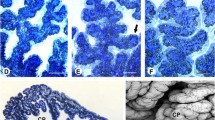Abstract
The development of the ciliary body was examined by scanning electron microscopy in human embryos and fetuses with a gestation age of 9.5 to 24 weeks. During this period it was possible to follow up the main morphogenetical events, beginning with the appearance of the first radial folds up to the occurrence of ciliary processes with a rather adultlike arrangement. The ciliary processes observed during week 24 differed from those of the adult eye only by their dimensions and the lack of surface infoldings. A primitive pars plana could only be identified during week 24. The morphological basis for aqueous humor production is discussed.
Similar content being viewed by others
References
Bach L, Seefelder R (1911) Atlas zur Entwicklungsgeschichte des menschlichen Auges. Engelmann, Leipzig Berlin
Barber AN (1955) Embryology of the human eye. Mosby, St. Louis
Bard JBL, Ross ASA (1982) The morphogenesis of the ciliary body of the avian eye. Dev Biol 92: 73–86
Duke-Elder S, Cook CH (1963) Normal and abnormal development. In: Duke-Elder S (ed) System of ophthalmology, vol 3, part 1, Embryology. Mosby, St. Louis
Hogan MJ, Alvarado JA, Wedell JE (1971) Histology of the human eye. Saunders, Philadelphia
Kelemen E, Janossa M, Calvo W, Fliedner TM (1984) Developmental age estimated by bone-length measurement in human fetuses. Anat Rec 209: 547–552
Kinsey VE, Jackson B (1949) Investigation of the blood-aqueous barrier in the newborn to ascorbic acid. Am J Ophthalmol 32: 374–378
Mann I (1964) The development of the human eye, 3rd edn. Grune & Stratton, New York
Ozanics V, Jakobiec FA (1983) Prenatal development of the eye and its adnexa. In: Duane TD, Jaeger EA (eds) Biomedical foundations of ophthalmology, vol 1. Harper & Row, Philadelphia
Streeten BW (1982) Ciliary body. In: Jakobiec FA (ed) Ocular anatomy, embryology and teratology. Harper & Row, Philadelphia, pp 303–330
Weale RA (1982) A biography of the eye. Lewis, London
Wulle K-G (1966) Frühentwicklung der Ziliarfortsätze im menschlichen Auge. Phasenkontrast- und elektronenmikroskopische Untersuchungen. Z Zellforsch 71: 545–561
Wulle K-G (1967) Elektronenmikroskopie der Kapillarentwicklung in menschlichen Ziliarfortsätzen. Verh Anat Ges 61: 465–473
Wulle K-G (1967) Zelldifferenzierungen im Ziliarepithel während der menschlichen Fetalentwicklung und ihre Beziehungen zur Kammerwasserbildung. Graefe's Arch Clin Exp Ophthalmol 172: 170–179
Wulle K-G (1972) The development of the productive and drainage system of the aqueous humor in the human eye. Adv Ophthalmol 26: 296–355
Author information
Authors and Affiliations
Additional information
This study was performed under the support of a training grant in ophthalmic electron microscopy from Deutsche Forschungsgemeinschaft
Rights and permissions
About this article
Cite this article
Sellheyer, K., Spitznas, M. Surface morphology of the human ciliary body during prenatal development. Graefe's Arch Clin Exp Ophthalmol 226, 78–83 (1988). https://doi.org/10.1007/BF02172723
Received:
Accepted:
Issue Date:
DOI: https://doi.org/10.1007/BF02172723




